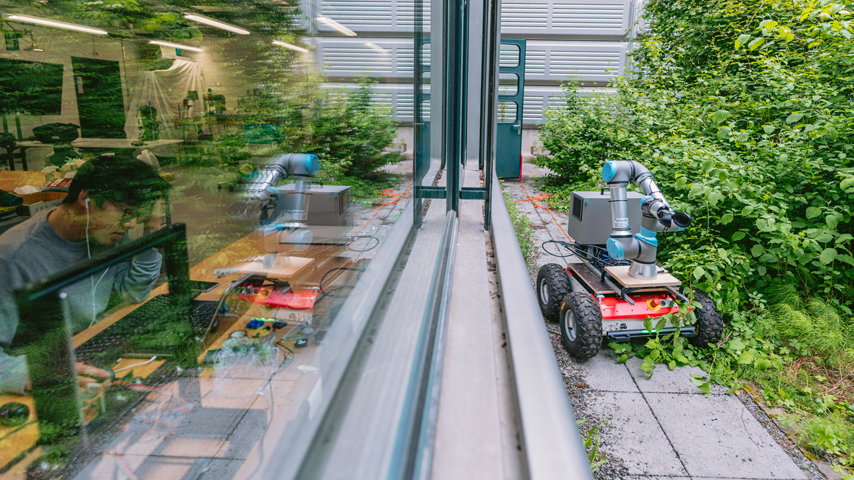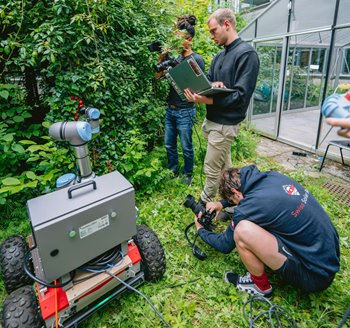“ChatGPT, Make a Robot”
“ChatGPT, Make a Robot”


Roboticists at EPFL elicited and built a robot whose every part was dictated by ChatGPT.
Robots build robots. Of course they do. At giant robot manufacturers, like ABB or Kuka, robots help make robots every day, and self-assembling robots, like the one created by MIT’s Center for Bits and Atoms last year, are on the rise as well. But the designing of robots, from the conception of their purpose to the coding that dictates their movements; from the choice of actuators to the shape of their grippers—humans have always done that part.
But now, thanks to the efforts—or obedient industriousness—of researchers at Switzerland’s EPFL University, there’s a robot designed entirely by ChatGPT.
“We were curious to see if these large language models also had some kind of internal representation of how a robot should be built and designed and realized, and to what extent,” said Cosimo Della Santina, a professor at the university’s cognitive robotics department. “So, we put ourselves in the shoes of someone that does not know anything about robotics.”
They started without a goal in mind, asking the AI general questions, like, “Can you name some of the main challenges that humanity will face and their implications?” (which was actually the first entry of their dialogue with the AI). ChatGPT thought that maintaining a stable food supply was a pretty important issue (as was the climate and our aging population). So they asked it what role agricultural robots might play. Soon, the chatbot had steered them into creating a tomato-harvesting robot with soft grippers, complete with material suggestions, instructions on how to use a pully system, and, after a little coaxing, some code in Python to control its Dynamixel motor. At no point did the researchers question ChatGPT’s expertise or ask it to come up with another answer.
Become a Member: How to Join ASME
“We were largely the passive agent,” said Della Santina. “It was doing most of the work and then, in the end, we had to do the technical work that was needed to transfer text-based things into real systems.”
The result was a perfectly plausible, if a bit run-of-the-mill, fruit-plucking robot, which proved its mettle gathering tomatoes from a garden on campus.
Della Santa and his colleagues are of course trained roboticists and may have had a bias when selecting which of the options ChatGPT offered. So they are now running the experiment again, this time with engineering students who are not roboticists.
Bias or no, Della Santina was impressed by the many areas of knowledge known to the AI. It knew who most needed robots, how to build one, and how to program its components. Though ChatGPT’s knowledge in any one area wasn’t particularly advanced, it displayed a “breadth of knowledge that, put together, would have required a small team of students to create,” Della Santina said. He was also pleased to see the AI agreeing with him about the role of passive compliance, or how much of a system’s intelligence comes from its body, as opposed to its brain. “I’m a big believer, so it was nice to see ChatGPT was proposing it,” he said.
More for You: Robotic Gripper's Soft Touch Promises Gentler Blackberry Harvest Automation
The tomato picker ChatGPT developed was a perfectly useful bit of robotics. In fact, several companies contacted Della Santina hoping to buy one. “I told them that they can do it themselves and I am happy to be of help if they need any,” he said. And Della Santina is confident that he could have submitted the product to a robotics conference and had it accepted. But ChatGPT was certainly not doing anything revolutionary.
“What we are seeing here is a kind of merging or reshuffling of known stuff,” said Della Santina. “There is a big risk that this will actually hinder the overall innovation of researchers if we end up automatically relying on something which is just mixing things instead of innovating.” On the other hand, maybe having a large language model do the boring stuff will free up roboticists to give more time to the creative part of their careers.
Given free rein to make his own tomato picker, Della Santina’s robot probably wouldn’t look much like the one ChatGPT developed. “I would have liked to see something which is more versatile and could have not just harvested tomatoes, but maybe also manipulated the plant or harvested different kinds of fruits,” he said.
Whatever their involvement in the future of robot design, there’s bound to be a major value shift as AI performs more jobs once thought wholly human. “This is going to happen more and more,” said Della Santina. “At some point, I think we should probably learn to stop evaluating ourselves in terms of what we produce.”
Michael Abrams is a technology writer in Westfield, N.J.
